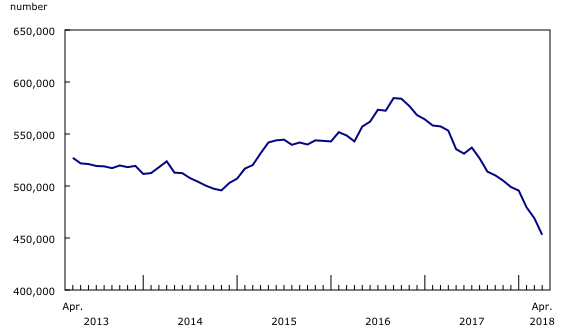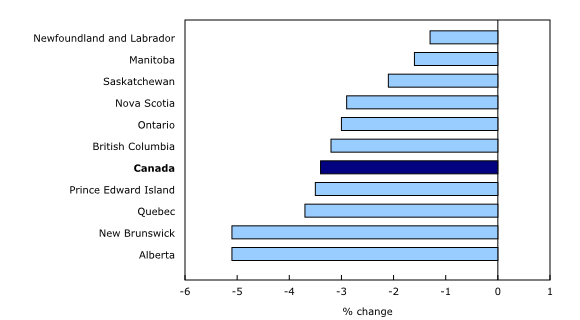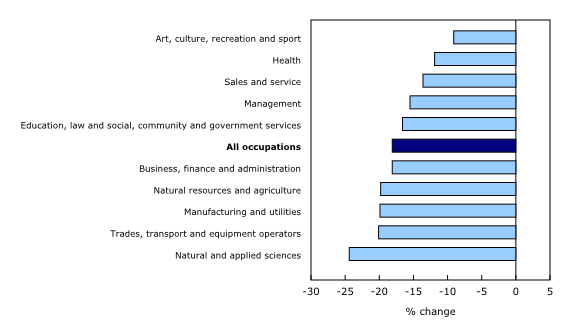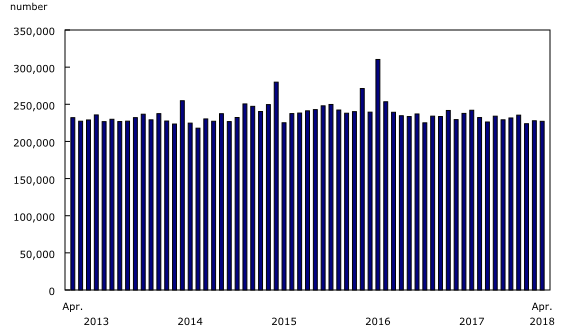Employment Insurance, April 2018
Archived Content
Information identified as archived is provided for reference, research or recordkeeping purposes. It is not subject to the Government of Canada Web Standards and has not been altered or updated since it was archived. Please "contact us" to request a format other than those available.
Released: 2018-06-21
In April, 453,100 people received regular Employment Insurance (EI) benefits, down 15,900 (-3.4%) from March, continuing the downward trend that began in the fall of 2016. The number of EI beneficiaries in April was at its lowest level since comparable data became available in 1997.
There were fewer beneficiaries in every province, notably in Alberta (-5.1%) and New Brunswick (-5.1%). Declines in the other provinces ranged from 3.7% in Quebec to 1.3% in Newfoundland and Labrador. The provincial declines in the number of beneficiaries follow real gross domestic product (GDP) growth in every province in 2017 for the first time since 2011.
In the 12 months to April, the number of EI recipients in Canada fell by 100,200 (-18.1%). Over the same period, the Labour Force Survey (LFS) showed the unemployment rate trending down to 5.8% in April.
In general, variations in the number of beneficiaries can reflect changes in the circumstances in a number of different groups, including those becoming beneficiaries, those going back to work, those exhausting their regular benefits, and those no longer receiving benefits for other reasons.
Provincial and sub-provincial overview
In Alberta, 56,300 people received benefits in April, down 3,000 (-5.1%) from March. Decreases were observed throughout the province, led by the census metropolitan area (CMA) of Edmonton (-7.3%). At the same time, the number of beneficiaries fell by 3.5% in the Calgary CMA. In the 12 months to April, the number of EI recipients in the province fell by 28.7%, the sharpest decrease among the provinces. The number of beneficiaries in Alberta has followed a downward trend that began in the fall of 2016. Coinciding with the declining trend in the number of beneficiaries, the province recorded real GDP growth of 4.9% in 2017, following declines of 3.9% in 2015 and 3.6% in 2016.
In New Brunswick, 27,800 people received regular benefits in April, down 5.1% from March. This was the largest of five consecutive monthly declines. All regions of the province had fewer beneficiaries in April, most notably the census agglomerations (CAs), which were down 6.5%. At the same time, the number of beneficiaries fell by 5.1% in the CMA of Saint John and by 4.7% in the Moncton CMA. The number of recipients in areas outside of the CMAs and CAs declined by 4.6%. Compared with April 2017, the number of EI recipients in the province fell by 16.1%.
In April, there were 104,100 EI recipients in Quebec, down 3.7% from the previous month. The number of beneficiaries in the province has trended down sharply, especially since the summer of 2017. The unemployment rate has also been on a downward trend and reached 5.4% in April, as reported by the LFS. There were fewer beneficiaries in five of the six CMAs, led by Ottawa–Gatineau (Quebec part) (-4.3%) and Montréal (-4.0%). There were also fewer beneficiaries in the CAs (-4.4%) and in areas outside of the CMAs and CAs (-3.6%). In the 12 months to April, the number of recipients in the province fell by 24.3%.
The number of people receiving EI benefits in Prince Edward Island declined by 3.5% to 7,800, with the decrease widespread throughout the province. On a year-over-year basis, the number of recipients fell by 4.3%.
In British Columbia, 42,100 people received regular benefits in April, down 3.2% from March. This extends a downward trend that began in the fall of 2016. Declines were observed in three of the four CMAs, most notably in Kelowna (-5.5%). The CAs (-4.7%) and areas outside the CMAs and CAs (-4.3%) also saw fewer recipients in April. In the 12 months to April, the number of EI recipients declined by 21.9% in the province, the 12th consecutive month of year-over-year declines and the fastest since November 2011.
EI beneficiaries in Ontario totalled 115,800 in April, down 3.0% from the previous month. There were notable declines in 8 of the 15 provincial CMAs, led by Windsor (-7.1%), London (-6.7%) and Oshawa (-6.6%). The province's CAs (-3.2%) also recorded fewer beneficiaries in April. On a year-over-year basis, the number of beneficiaries in the province fell by 21,600 (-15.7%), with the Toronto CMA accounting for just over one-third of the decline.
The number of EI recipients in Nova Scotia fell by 2.9% in April to 26,500, with the decrease widespread across the province. Compared with April 2017, the number of beneficiaries in Nova Scotia was down by 7.2%.
There were 17,300 EI beneficiaries in Saskatchewan in April, down 2.1% from March. The number of people receiving benefits has trended down since December 2016. In April, fewer recipients were reported in the CMAs of Regina (-5.7%) and Saskatoon (-2.1%). At the same time, fewer people in the province's CAs (-4.2%) received benefits. In the 12 months to April, the number of EI beneficiaries in Saskatchewan declined by 10.0%.
In Manitoba, 15,200 people received benefits in April, down 1.6% from the previous month. The CMA of Winnipeg reported a 1.7% decline, and there were also fewer recipients outside the CMAs and CAs (-1.4%). In the 12 months to April, the number of beneficiaries decreased by 3.0% in the province, in large part the result of declines in March and April.
In Newfoundland and Labrador, 37,300 people received EI benefits in April, down slightly (-1.3%) from March. Declines were observed outside CMAs and CAs (-1.7%). Compared with April 2017, the number of beneficiaries in the province fell by 3.5%, the first notable year-over-year decline since the summer of 2017.
Employment Insurance beneficiaries by occupation
The number of beneficiaries fell on a year-over-year basis in all 10 broad occupation groups. The largest declines in April were among those whose last job was in natural and applied sciences (-24.4%); trades, transport and equipment operators (-20.1%); manufacturing and utilities (-19.9%); and natural resources (-19.8%). In the 12 months to April, New Brunswick, Quebec, Ontario and Alberta posted year-over-year declines in all broad occupation groups.
Employment Insurance beneficiaries in major demographic groups
Compared with March, there were fewer EI recipients among men (-3.9%) and women (-2.6%) in every major age group in April. Declines were largest for young women (-6.3%) and young men (-5.0%) aged 15 to 24.
In the 12 months to April, the number of beneficiaries declined in every major demographic group, led by young men (-26.8%) and men aged 25 to 54 (-22.0%). Declines were faster for men than for women across all major age groups.
Employment Insurance claims
The number of claims totalled 227,100 in April, little changed from March. The number of claims provides an indication of the number of people who could become beneficiaries.
In April, claims fell in Quebec (-4.4%), Nova Scotia (-2.2%), Ontario (-1.6%) and British Columbia (-1.3%). In contrast, there were increases in Saskatchewan (+12.6%), Newfoundland and Labrador (+9.9%) and Alberta (+9.4%). There was little change in Prince Edward Island, Manitoba and New Brunswick.
In the 12 months to April, claims decreased by 6.0% nationally.
Note to readers
Historical revision
With the June 21, 2018, release of April data, the seasonally adjusted series of Employment Insurance (EI) statistics were revised back to January 2000 to reflect the most recent seasonal factors.
Concepts and methodology
The analysis presented here focuses on people who received regular Employment Insurance (EI) benefits related to job loss. Claims data pertain to initial and renewal claims received for any type of EI benefits, including special benefits.
EI statistics are produced from administrative data sources provided by Service Canada and Employment and Social Development Canada. These statistics may, from time to time, be affected by changes to the Employment Insurance Act or administrative procedures.
Regular EI benefits are available to eligible individuals who lose their jobs and who are available for and able to work, but cannot find a job. To receive EI benefits, individuals must first submit a claim.
EI statistics indicate the number of people who received EI benefits, and should not be confused with Labour Force Survey (LFS) data, which provide estimates of the total number of unemployed people. There is always a certain proportion of unemployed people who do not qualify for benefits. Some unemployed people have not contributed to the program because they have not worked in the past 12 months or their employment is not insured. Other unemployed people have contributed to the program but do not meet the eligibility criteria, such as workers who left their job voluntarily or those who did not accumulate enough hours of work to receive benefits.
All data in this release are seasonally adjusted. For more information on seasonal adjustment, see Seasonally adjusted data – Frequently asked questions.
Numbers in the Daily text are rounded to the nearest hundred.
The number of regular EI beneficiaries and the number of claims received for the current and previous month are subject to revision.
The number of beneficiaries is a measure of all people who received EI benefits from April 15 to 21. This period coincides with the reference week of the LFS. However, claims data are for the entire month.
Geographical definitions
A census metropolitan area (CMA) or a census agglomeration (CA) is formed by one or more adjacent municipalities centred on a population centre. A CMA must have a total population of at least 100,000. A CA must have a population of at least 10,000. See Standard Geographical Classification 2011 – definitions for more information.
Next release
Data on Employment Insurance for May will be released on July 19.
Products
More information about the concepts and use of Employment Insurance statistics is available online in the Guide to Employment Insurance Statistics (73-506-G).
Contact information
For more information, contact us (toll-free: 1-800-263-1136; 514-283-8300; STATCAN.infostats-infostats.STATCAN@canada.ca).
To enquire about the concepts, methods or data quality of this release, contact Vincent Ferrao (613-951-4750; vincent.ferrao@canada.ca) or Client Services (toll free: 1-866-873-8788; statcan.labour-travail.statcan@canada.ca), Labour Statistics Division.
- Date modified:







